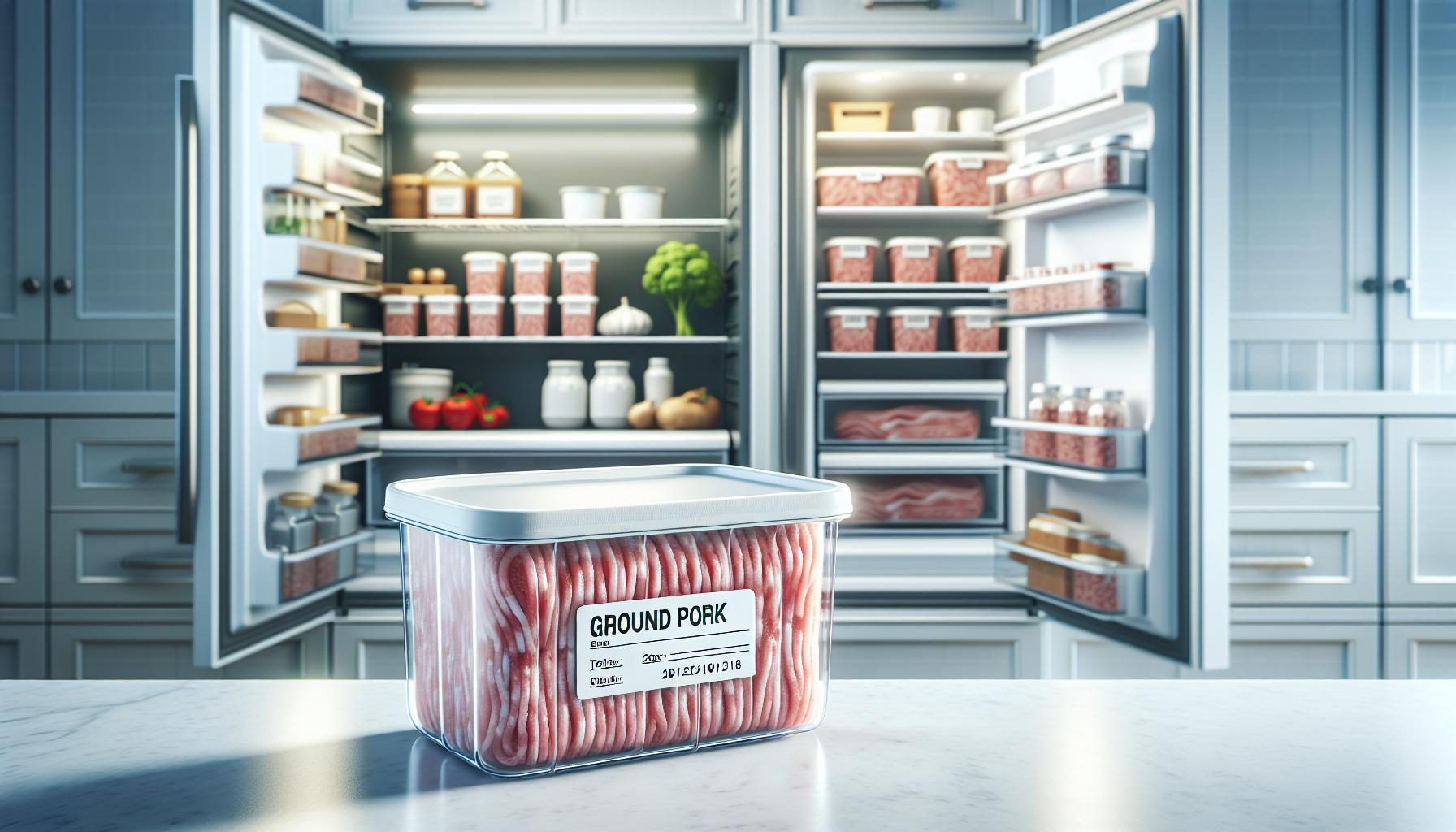When it comes to cooking, ground pork can be a delicious and versatile choice, but how long it stays safe and fresh in the fridge often raises questions. Did you know that improperly stored ground pork can lead to foodborne illnesses? Understanding the storage guidelines for this popular meat is crucial for ensuring your meals are both tasty and safe.
With many of us juggling busy schedules, knowing how to store ground pork effectively helps prevent waste while keeping your family healthy. Whether you’re planning a last-minute dinner or meal prepping for the week ahead, having clear knowledge of how long ground pork can last in your fridge is essential. In this guide, we’ll cover everything you need to know to make informed decisions and safely enjoy your ground pork. Read on to discover vital tips and insights that will keep your meals fresh and your mind at ease.
Factors Affecting Ground Pork Shelf Life
Ground pork, like other types of ground meat, has a relatively short shelf life and is subject to various factors that influence how long it remains safe to eat. Understanding these factors is primarily about keeping safety and freshness in mind. One major factor is temperature. Ground pork should always be stored in the refrigerator at a temperature of 40°F (4°C) or lower. If the meat is left at room temperature, bacteria can grow rapidly, leading to foodborne illnesses. Therefore, it’s vital to refrigerate or freeze ground pork promptly after purchasing.
Another significant influence on shelf life is packaging. If ground pork is bought in vacuum-sealed packages, it can last longer compared to products wrapped in butcher paper or styrofoam trays, as the latter may introduce more air, increasing exposure to bacteria. The expiration date or “sell by” date indicated on the packaging also plays a critical role. While ground pork can sometimes be safe to use a day or two after this date, it is essential to rely on other indicators of freshness.
Lastly, hygiene practices during handling are crucial. Using clean utensils and surfaces, washing hands regularly, and avoiding cross-contamination with other foods can significantly affect the safety of ground pork. Storage conditions, such as ensuring that the meat is kept away from strong-smelling foods, can help maintain its quality over time. By paying attention to these factors, you can better ensure that your ground pork remains safe and fresh for as long as possible.
Best Practices for Storing Ground Pork in the Fridge

Storing ground pork properly is essential to maintain its freshness and safety, especially since it has a shorter shelf life compared to whole cuts of meat. Ground pork should be kept in the refrigerator at a temperature of 40°F (4°C) or lower to inhibit bacterial growth. Ideally, it’s best to consume or cook ground pork within 1-2 days of purchase for optimal taste and safety. However, if you’re unable to use it right away, implementing best practices for storage can extend its usability.
To ensure ground pork stays fresh in the fridge, keep it in its original packaging as long as it’s vacuum-sealed. If it’s not vacuum-sealed, consider transferring it to an airtight container or wrapping it tightly in plastic wrap to limit exposure to air, which can accelerate spoilage. Additionally, store ground pork on the bottom shelf of the refrigerator to prevent any potential drips from contaminating other foods. Having a designated section of the fridge for raw meats can help maintain organization and prevent cross-contamination.
It’s also beneficial to label the packaging with the date of purchase, which can remind you of its freshness timeline. If you detect any off smells, discoloration, or a slimy texture, it’s critical not to consume the pork, as these are telltale signs that it has gone bad. Observing proper hygiene practices, such as washing hands before and after handling raw meat, will further ensure a safe cooking environment and reduce the risk of foodborne illnesses. By adhering to these guidelines, you’ll not only maximize the shelf life of your ground pork but also uphold food safety standards in your kitchen.
By maintaining vigilant storage practices, you can enjoy delicious meals while minimizing waste and ensuring safe consumption.
Signs Ground Pork Has Gone Bad

Ground pork is a versatile ingredient in many dishes, but it can spoil quickly if not monitored carefully. Knowing the signs that ground pork has gone bad is crucial to ensuring food safety and preventing foodborne illnesses. When opening a package of ground pork, the first thing to do is to take a good look and sniff. Fresh ground pork should have a light pink color and a mild meaty smell. Any deviation from this indicates that the meat may be past its prime.
One of the most noticeable signs of spoilage is a change in color. If the ground pork has developed a grayish or yellow tint, it is best to err on the side of caution and discard it. Furthermore, the texture of spoiled ground pork may become sticky, tacky, or overly slimy, which can be alarming. If you notice any unusual textures, such as a film or slime forming on the surface, this is a clear indication that bacteria have begun to multiply, and the pork should not be consumed.
Another important factor to consider is the smell. Fresh ground pork should have a faint, clean meat smell. If it emits a sour, rancid, or off-putting odor, this is a strong signal that the meat has gone bad and should not be cooked or eaten. You should trust your senses – if it smells wrong, it most likely is.
To prevent waste and ensure safety when it comes to ground pork, always check for these signs before cooking or consuming it, especially if it has been stored in the refrigerator for more than a couple of days. Remember, if you’re ever in doubt about the freshness of your meat, it’s always safer to throw it away than risk food poisoning. By following these guidelines, you can maintain not only the quality of your meals but also the health of everyone at your table.
How to Properly Freeze Ground Pork

When it comes to preserving the quality and safety of ground pork, freezing is one of the best options available. This method can significantly extend its shelf life while maintaining flavor and texture, allowing you to enjoy your favorite dishes without the worry of spoilage. Properly frozen ground pork can last up to four months in the freezer and still retain its quality, so understanding the nuances of freezing this ingredient is essential.
To ensure ground pork freezes effectively, start by dividing it into smaller portions. Using airtight freezer bags or vacuum sealers minimizes exposure to air, which can cause freezer burn-a condition that degrades both texture and flavor. Make sure to remove as much air as possible from the storage bags before sealing. Clearly label each package with the date and contents so you can easily keep track of your supplies.
Step-by-Step Freezing Guide
- Prepare the Meat: If your ground pork is still in its original packaging, decide if you need to repackage it. For longer storage, it’s advisable to transfer it to a freezer-safe bag.
- Portion It Out: Divide the ground pork into standard meal-sized portions (for example, one pound each) to make thawing easier later.
- Seal It Up: Remove as much air as possible before sealing the bags tightly. Consider vacuum-sealing if you have the equipment for optimal freshness.
- Label and Organize: Write the date and type of meat on the packaging, and place the bags flat in the freezer to save space. Arrange them in a way that you can easily access them later.
Once it’s time to use your frozen ground pork, it’s important to thaw it safely. The best way to do this is either in the refrigerator overnight or using the cold water method, where the sealed package is submerged in cold water and replaced every 30 minutes. Avoid thawing at room temperature, as this can promote the growth of harmful bacteria.
By following these guidelines, you can freeze ground pork properly, ensuring that it remains a versatile and safe ingredient ready for your culinary creations. With the right storage practices in place, you can enjoy the convenience of having ground pork on hand while minimizing waste and maintaining food safety.
Thawing Ground Pork: Safety Tips
Thawing ground pork safely is crucial to ensuring that it remains a safe and nutritious ingredient for your meals. One of the most important guidelines to remember is to avoid thawing at room temperature, as this can create an environment conducive to the growth of harmful bacteria. Instead, utilize one of the following safe methods for thawing.
The refrigerator method is the safest and most recommended approach. Simply place the sealed package of ground pork in the refrigerator for several hours or overnight, depending on its thickness. This method keeps the meat at a safe and consistent temperature, making it less likely for bacteria to proliferate. Always plan ahead, as this method requires time but ensures optimum safety.
If you’re short on time, you can also use the cold water method. Make sure the ground pork is in a tightly sealed package; submerge it in a bowl of cold water, changing the water every 30 minutes. This will expedite the thawing process while still keeping the pork at a safe temperature. Remember, never use hot water, as this can rapidly raise the temperature of the outer layer of the meat, promoting bacterial growth.
Once thawed, it’s best to cook ground pork immediately. If you decide to refreeze it, ensure that it hasn’t been left at room temperature for more than two hours prior to refreezing, as this can compromise safety. By adhering to these thawing guidelines, you can preserve not only the quality of your ground pork but also the health of those who eat it.
Cooking Ground Pork: Ensuring Food Safety
Cooking ground pork to appropriate temperatures is crucial not only for flavor but also for food safety. Ground pork should always be cooked to an internal temperature of at least 160°F (71°C). Using a food thermometer is the best way to ensure your ground pork reaches this safe temperature, as it effectively kills harmful bacteria like Salmonella and E. coli that can cause foodborne illnesses. Cooking ground pork without adequate attention to temperature can lead to serious health risks, so it’s essential to treat this meat with care from preparation to serving.
In preparing ground pork, be mindful of cross-contamination. Use separate cutting boards and utensils for raw pork and ready-to-eat foods to prevent any transfer of bacteria. Washing hands, surfaces, and cooking tools with warm soapy water before and after handling meat is a key practice to maintain a clean cooking environment. Moreover, ensure that cooking surfaces are hot enough before adding the meat, as this helps to sear the pork, sealing in juices and flavors while also creating a barrier against bacteria.
Once cooked, ground pork should not be left out at room temperature for longer than two hours. If the room temperature exceeds 90°F (32°C), this timeframe is reduced to just one hour. Rapidly cooling cooked pork by transferring it to shallow containers and refrigerating can help prevent bacterial growth. If you have leftovers, store them in an airtight container in the refrigerator and consume them within 3 to 4 days for best results. Always reheat leftovers to 165°F (74°C) before serving, ensuring they are hot throughout.
By adhering to these guidelines, you can enjoy delicious meals made with ground pork while ensuring safety for you and your loved ones. The effort you put into proper cooking and handling practices will result in a satisfying and safe culinary experience.
What to Do with Leftover Ground Pork
Leftover ground pork can be a versatile and delicious ingredient for your future meals, but it’s important to handle it properly to ensure food safety. After cooking, any leftover ground pork should be stored in an airtight container in the refrigerator within two hours to minimize the risk of bacterial growth. Consuming these leftovers within 3 to 4 days is ideal for maintaining quality and safety. If you anticipate not using the leftovers within this timeframe, consider freezing them for longer storage.
When repurposing leftover ground pork, creativity is key. This meat can be transformed into an array of dishes. Here are some practical ideas:
- Tacos or Burritos: Reheat the ground pork and load it into taco shells or burritos with your favorite toppings like lettuce, cheese, salsa, and avocado.
- Pasta Dishes: Mix it into tomato sauce for spaghetti or envelop it in lasagna layers for added protein and flavor.
- Stir-Fries: Combine the pork with vegetables and teriyaki sauce for a quick and wholesome stir-fry.
- Soup or Chili: Incorporate it into hearty soups or chili for an easy, flavorful meal.
To reheat ground pork, ensure it reaches an internal temperature of 165°F (74°C) to eliminate any harmful bacteria. Use a food thermometer for accuracy and allow it to heat evenly, stirring occasionally to prevent hot spots. If you decide to freeze the leftovers, first place them in freezer-safe bags or containers, removing as much air as possible to prevent freezer burn. Ground pork can be stored in the freezer for up to 3 to 4 months while maintaining its best quality.
Being mindful of portion sizes also helps reduce waste. Consider dividing leftovers into meal-sized portions before storing, making it easier to heat up just what you need. This practice not only helps in managing food safety but also encourages variety in your meals by allowing you to experiment with different recipes throughout the week.
Understanding the Importance of Expiration Dates
Expiration dates are critical indicators of the safety and quality of ground pork, providing essential guidance for consumers who want to avoid foodborne illnesses. The date listed on the packaging can signify several things: the last day the product is at its peak quality, the sell-by date for retailers, or the expiration date for use. Understanding these distinctions empowers you to make informed decisions about when to consume or discard food, reducing wastage and enhancing safety.
Ground pork, like other perishable products, should be consumed or frozen before it reaches its expiration date. Typically, raw ground pork can safely be kept in the refrigerator for 1 to 2 days after purchase, while cooked ground pork should be consumed within 3 to 4 days. It is important to note that expiration dates are not arbitrary; they are based on extensive safety testing and are designed to ensure food quality. Ignoring these dates can lead to serious health risks, including food poisoning caused by harmful bacteria such as Salmonella or E. coli, which can thrive if the pork is stored beyond its safe time frame.
It’s also beneficial to be aware of the storage conditions under which the meat should be kept. Ground pork must be stored at temperatures below 40°F (4°C) in the refrigerator to slow bacterial growth. If you notice that the expiration date is approaching, consider either cooking the meat or freezing it to extend its shelf life beyond the noted date. When freezing, ensure it’s tightly sealed to prevent freezer burn, which can damage the meat’s quality.
By adhering to the expiration dates and proper storage practices, you significantly lower the risk of food safety issues, ensuring that your meals are not only delicious but safe for you and your loved ones. Always prioritize checking these dates as part of your culinary routine; doing so can save you from unnecessary health hazards and ensure that your ground pork dishes are both fresh and flavorful.
Storage Solutions: Containers and Environment
Storing ground pork properly is essential to maintain its freshness and prevent foodborne illnesses. The right containers and environmental conditions can significantly extend the shelf life of your meat, ensuring that it remains safe to consume. When it comes to containers, airtight packaging is key. Consider using vacuum-sealed bags, which help eliminate air and reduce the risk of freezer burn-a common issue that can negatively impact the quality of the meat. If vacuum sealing isn’t an option, you can use resealable plastic bags or airtight containers. Always squeeze out excess air when sealing bags, as this will help preserve the meat’s flavor and texture.
Temperature is another critical factor in the storage environment. Ground pork should be stored in the coldest part of your refrigerator, ideally set below 40°F (4°C). Placing it near the back of the fridge can help achieve this, as the temperatures tend to be colder away from the door. Be mindful of consistently monitoring your fridge’s temperature; an appliance thermometer can be a valuable tool for this. Additionally, if the meat is not used within 1 to 2 days, freezing is your best option. For freezing, use a freezer-safe container or bag, label with the date prepared, and aim to consume it within 3 to 4 months for optimal quality.
Best Practices for Storage:
- Use airtight containers or vacuum-sealed bags.
- Store in the coldest part of your refrigerator.
- Monitor refrigerator temperature below 40°F (4°C).
- If freezing, label packaging with the date and consume within 3-4 months.
For those who are conscious about environmentally sustainable practices, consider using reusable silicone bags as a viable alternative to single-use plastic bags. These bags offer excellent sealing capabilities without contributing to waste. Ensure that any containers used for storage are clean and dry before placing the ground pork inside, as moisture can encourage bacterial growth.
By following these storage solutions, you can help ensure that your ground pork remains safe to eat and retains its best quality, allowing you to make the most of your culinary endeavors without the worry of spoilage or waste.
Comparing Fresh vs. Frozen Ground Pork Storage
When it comes to ground pork, understanding the differences between fresh and frozen storage can greatly influence its safety, quality, and flavor. Fresh ground pork, when stored properly in the refrigerator, typically lasts about 1 to 2 days. This short shelf life requires careful management to ensure that it is used promptly and remains safe to consume. To maximize freshness, store the meat in the coldest section of the fridge and keep it sealed in an airtight container or tightly wrapped to minimize exposure to air, which can promote spoilage.
In contrast, freezing ground pork significantly extends its shelf life. When properly frozen, ground pork can last for 3 to 4 months without significant loss of quality. Freezing halts bacterial growth and preserves the meat’s flavor and texture, provided it is stored correctly. To freeze, place the ground pork in a freezer-safe bag or container, removing as much air as possible to prevent freezer burn. Label the packaging with the date of freezing to keep track of its freshness.
While fresh ground pork offers the best flavor, frozen ground pork can still be a great alternative when stored correctly. Properly thawed frozen ground pork can be used in a variety of recipes, maintaining both safety and quality. Always thaw in the refrigerator or during the cooking process to ensure it remains below safe temperature thresholds. Understanding these differences helps you make informed choices about meal prep and can prevent food waste while still delivering delicious results in your cooking.
Healthy Recipes for Leftover Ground Pork
Using leftover ground pork can not only help minimize food waste but also allow you to create delicious and nutritious meals. Ground pork is incredibly versatile and can feature prominently in a variety of dishes. Whether you are looking to whip up a quick weeknight dinner or meal prep for the week, consider these healthy recipes to make the most of your leftovers.
One simple yet satisfying option is to prepare ground pork stir-fry. In a hot skillet, sauté your choice of chopped vegetables-like bell peppers, broccoli, and snap peas-until tender. Add the ground pork, breaking it apart as it cooks. Season with soy sauce, garlic, and ginger for a flavorful kick. This dish cooks quickly and can be served over brown rice or quinoa for a balanced meal rich in protein and fiber.
Another nutritious choice is making stuffed bell peppers. Halve bell peppers and hollow them out, then fill with a mixture of cooked ground pork, quinoa, black beans, corn, and your favorite spices. Bake until the peppers are tender and the filling is heated through. This dish not only looks appealing but also packs a punch of vitamins and minerals, making it a healthy and filling option.
For a quick lunch, consider pork lettuce wraps. Sauté ground pork with diced onions, mushrooms, and water chestnuts, adding hoisin sauce for a hint of sweetness. Serve this mixture in crisp iceberg or butter lettuce leaves, topped with shredded carrots and chopped peanuts for added texture. These wraps are low in carbohydrates and high in flavor, perfect for a light yet satisfying meal.
Finally, if you are looking for something hearty, a pork and vegetable soup can be a great way to use leftover ground pork. Start by browning the pork in a large pot, then add broth, diced tomatoes, and any vegetables you have on hand such as carrots, zucchini, and spinach. Season well and simmer until the vegetables are tender. This soup is not only comforting but also packed with nutrients, making it an excellent meal option, especially during colder months.
By incorporating ground pork into these healthy recipes, you can enjoy varied meals throughout the week while keeping food safety in mind. Remember to consume any leftover ground pork within 3 to 4 days of cooking, and if you won’t be using it within that timeframe, freezing it can help extend its shelf life significantly. Happy cooking!
FAQ
Q: How can I tell if ground pork is still good to eat?
A: You can determine if ground pork is still safe to eat by checking for changes in color, texture, and smell. Fresh ground pork should be pinkish-red in color. If it turns gray or has a sour odor, it’s best to discard it. For more detailed signs of spoilage, refer to the “Signs Ground Pork Has Gone Bad” section of our article.
Q: What is the best way to store ground pork in the fridge?
A: The best way to store ground pork in the fridge is to keep it in its original packaging or rewrap it tightly in plastic wrap or aluminum foil. Ensure it’s stored in the coldest part of the fridge, typically at or below 40°F (4°C), to maximize its freshness. Visit the “Best Practices for Storing Ground Pork in the Fridge” section for more tips.
Q: Can I reuse ground pork packaging for storage?
A: It’s not advisable to reuse ground pork packaging for storage. Once opened, transfer the meat to a clean, airtight container to prevent contamination and maintain freshness. For additional storage solutions, see the “Storage Solutions” section in our article.
Q: How long can cooked ground pork last in the fridge?
A: Cooked ground pork can last in the fridge for about 3 to 4 days if stored properly in an airtight container. Always ensure it is cooled before refrigerating to maintain quality. Check the “What to Do with Leftover Ground Pork” section for tips on storing leftovers.
Q: Is it safe to eat ground pork past its sell-by date?
A: Ground pork can sometimes be safe to eat up to the sell-by date if stored properly, but it’s crucial to check for signs of spoilage. Always evaluate the meat’s color, smell, and texture before consumption. Refer to the section on “Understanding the Importance of Expiration Dates” for more guidance.
Q: What temperature should ground pork be cooked to for safety?
A: Ground pork should be cooked to an internal temperature of 160°F (71°C) to ensure it’s safe to eat. Use a meat thermometer to accurately check the temperature. For cooking tips, see the “Cooking Ground Pork: Ensuring Food Safety” section of our article.
Q: Can I freeze leftover ground pork, and how should I do it?
A: Yes, you can freeze leftover ground pork. Make sure to package it in an airtight container or heavy-duty freezer bag, removing as much air as possible. This will prevent freezer burn. For best practices on freezing, check the “How to Properly Freeze Ground Pork” section.
Q: How long can ground pork be frozen before it goes bad?
A: Ground pork can be frozen for 3 to 4 months for optimal quality. While it remains safe to eat indefinitely if kept at 0°F (-18°C), quality may diminish over time. For detailed storage guidelines, refer to our “Comparing Fresh vs. Frozen Ground Pork Storage” section.
Closing Remarks
Storing ground pork properly is essential to ensuring its safety and freshness. Remember, this versatile meat lasts up to 1-2 days in the fridge if stored correctly. If you’re uncertain about its freshness, it’s always better to err on the side of caution. For more tips on safe food practices, explore our articles on “How to Store Meat Properly” and “Understanding Food Expiration Dates.”
Don’t let your culinary creations be compromised! Check our blog regularly for further insights and recipes that inspire you to make the most of your meals. If you found this guide helpful, consider subscribing to our newsletter for expert tips delivered straight to your inbox. Stay informed, stay safe, and keep cooking delicious meals!





